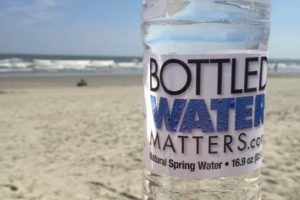Posted by Terrie // the shelby report
 The International Bottled Water Association (IBWA), in conjunction with research, consulting and financial services firm Beverage Marketing Corp. (BMC), has released 2015 bottled water statistics, which show that Americans’ consumption of bottled water increased by 7.9 percent and bottled water sales rose 8.9 percent vs. the previous year.
The International Bottled Water Association (IBWA), in conjunction with research, consulting and financial services firm Beverage Marketing Corp. (BMC), has released 2015 bottled water statistics, which show that Americans’ consumption of bottled water increased by 7.9 percent and bottled water sales rose 8.9 percent vs. the previous year.
BMC now indicates that bottled water is poised to overtake carbonated soft drinks as America’s largest beverage category by volume by 2017, if not by the end of 2016.
“Consumer demand for bottled water looks likely to remain strong in the years ahead. Increases in per capita consumption indicate enthusiasm for a product that consumers regard as a healthful alternative to other beverages,” said Michael Bellas, BMC chairman and CEO. “Americans increased their annual consumption by more than 11 gallons, from 25.4 gallons per person in 2005 to 36.5 gallons a decade later. During the same period, per capita consumption of carbonated soft drinks dropped by 12.4 gallons. Per capita consumption of other major beverage categories, like milk and fruit beverages, also fell.”
Reflecting a clear trend of consumers increasingly choosing bottled water, BMC reported that by 2015, bottled water had achieved a new volume record with almost 3 billion more gallons than in 2007.
For soft drinks, 2015 was the 11th consecutive year of declining volume.
Bottled water sales increased by 8.9 percent in 2015, and now total $14.2 billion (wholesale). In 2015, total U.S. bottled water consumption grew by 7.9 percent to 11.7 billion gallons, up from 10.87 billion gallons in 2014. In addition, per-capita consumption is up 7.1 percent in 2015, with every person in America drinking an average of 36.5 gallons of bottled water last year.
“There are many attributes that contribute to bottled water’s undeniable appeal to U.S. consumers,” said Chris Hogan, IBWA VP of communications. “Among them are bottled water’s healthfulness, convenience, reliability and safety.”
Environmental impact
The IBWA says the bottled water industry is utilizing a variety of measures to continue reducing its environmental impact. All bottled water containers are 100 percent recyclable and many bottled water companies already are using recycled plastic in their bottles. Some are producing 100 percent recycled PET plastic bottled water containers.
“Bottled water’s environmental footprint is the lowest of any packaged beverage, according to a life cycle assessment conducted by Quantis in 2010,” said Hogan. “Bottled water has the smallest water and energy use footprint of any packaged beverage. When it comes to overall water use, the bottled water industry is actually a small and efficient water user. Bottled water uses only 0.01 percent of all water used in the U.S.”
The bottled water industry works with recycling advocates, communities and its beverage and food partners to increase recycling rates. Between 2000 and 2014, the average weight of a 16.9-oz. (half-liter) PET plastic bottle declined 51 percent. This has resulted in a savings of 6.2 billion pounds of PET resin since 2000. At 37 percent, the recycling rate for single-serve PET plastic bottled water containers has more than doubled in the past 10 years, and PET plastic bottled water containers are the most frequently recycled PET beverage container in curbside recycling programs. PET plastic bottled water containers, measured in tons of landfill space, make up just 3.3 percent of all beverage containers that end up in landfills. Waste percentage numbers are much higher for the glass (66.7 percent), aluminum (7.9 percent) and plastic soda bottles (13.3 percent) that end up in landfills.
U.S. Food and Drug Administration (FDA) regulations governing the safety and quality of bottled water must, by law, be as stringent as the Environmental Protection Agency (EPA) standards for tap water.

